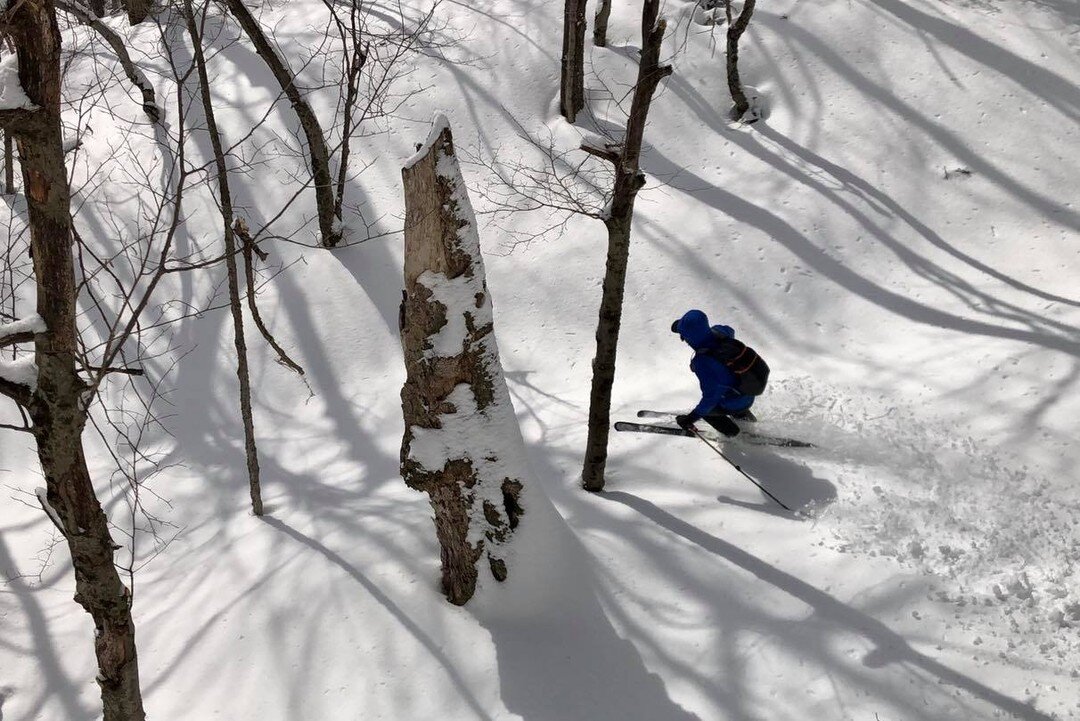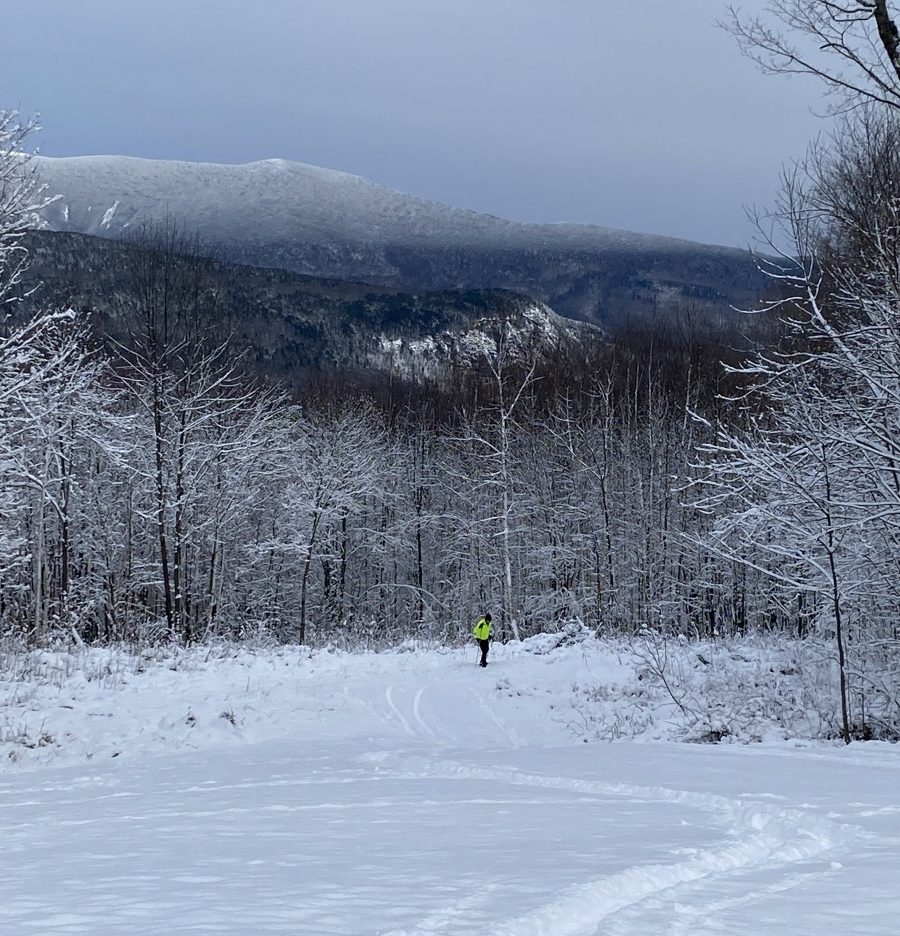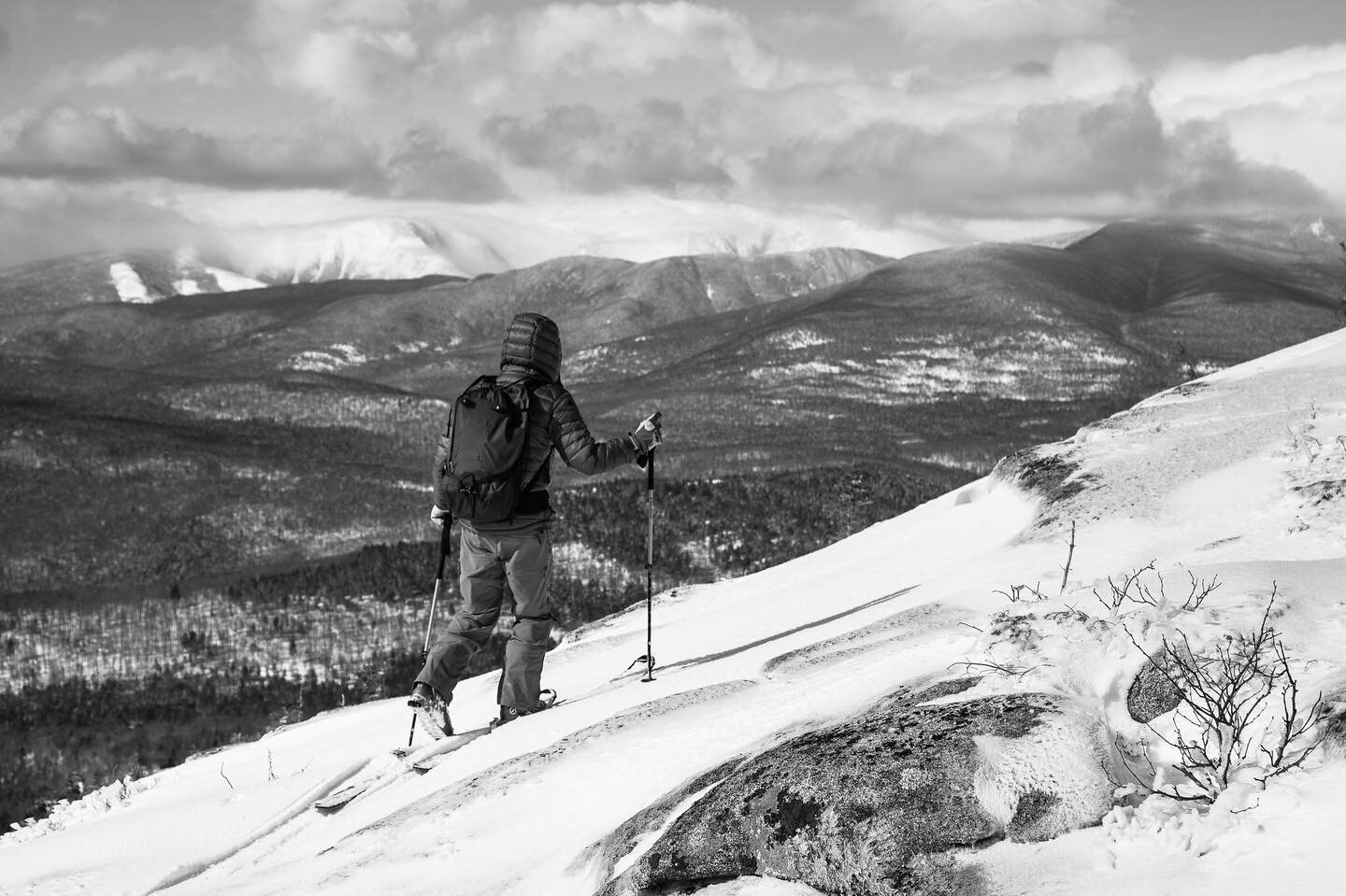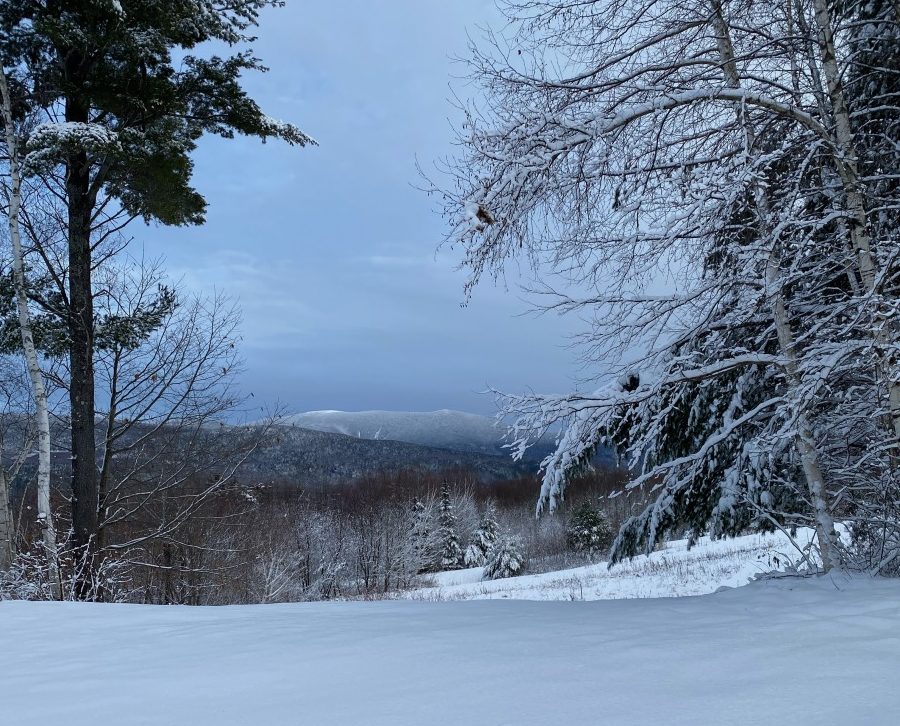 The Black & White Glade in the Andover / Rumford area Maine. Photo: Courtesy of GBA.
The Black & White Glade in the Andover / Rumford area Maine. Photo: Courtesy of GBA.
A sweet spot exists for tree density and turn radius when it comes to supreme glade skiing. If the trees are too thick, the turns shorten, the scene becomes a high-risk, low-reward, trees as slalom gates affair. Imagine this dog hair forest before the regular use of helmets. To play an overplayed word – I’m not sure flow would be part of this scenario’s energy state.
Contrast that tight-treed experience with fine glade skiing. No matter what coast you’re trending towards, the commonality is tress not too dense, turns maybe more GS, and a high enough and trees-just-close-enough speed, that the forest is an inalienable part of the experience.
For decades, the below-alpine glade skiing experience on the East Coast was more thicket-like. The higher Krumholz and alpine zones in the White and Green Mountains hold the goods, but not since the Civilian Conservation Corps (CCC) back in the Depression-era 1930s have the woods of New England seen a glade-creation-renaissance as they have in the last decade.
Warren Bunnell has spent the past few off-winter seasons strategically thinning his grandparents’ land in Pike, New Hampshire. On a large chunk of real estate roughly 20 miles due east of the Connecticut River, Bunnell, with the help of volunteers, has created skiable terrain on a series of northeast-facing glades. The skiable property, The Pike Glades, tops 2200′ while the base rests 1500 feet below at an elevation of 700 feet.
Bunnell, like many Eastern skiers, did a stint in Colorado. In places like that, which is a trait found across the deep-snow West, noses can be upturned at anything but the deepest and lightest of days. The dry spells between storm cycles are torture.

Trail setting at the Pike Glade under the gaze of Mount Moosilauke. one of the many 4000 footers populating New Hampshire.
Whether skiing a feathery 16 inches somewhere in Summit County or edging on scratchy boilerplate, “I had a great day, I didn’t really care where I was,” said Bunnell. “And then I went down to Australia, and I worked there for a season and it could be pissing rain, it could be sunny for two weeks straight. If there’s one ribbon of snow, they’re the happiest people alive to be on the mountain.”
Bunnell is getting at this: happiness, of which there’s likely a spectrum (see the fun scale), isn’t, or shouldn’t be, conditions dependent. Pike Glades is worthy of uphilling and then locking down for a gladed schuss if blessed with enough snow for coverage. Bunnell aims to attract users looking to unplug from a noisy on-piste scene. Beginners will find a place where skinning up is a friendly affair and, if someone is un-keen on a speedy descent, can glide down on skins.
The new Pike Glades are part of a broader and deeper trend in the Northeast to re-clear and reclaim ski runs buffed out by the Civilian Conservation Corps or generate new glades altogether. In New Hampshire and Western Maine, the Granite Backcountry Alliance (GBA) is the guiding light. Beyond the aim of ski glade creation, the GBA has linked private and public landowners to ensure access and a better skiing experience. (Who wants to get thwacked in the face with a branch?)
The GBA’s mission speaks to partnerships, collaboration, awareness, and stewardship. And, of course, expanding skiable and ridable terrain.
“Improving the foundation of the sport is critical to future success, such as creating partnerships and collaboration with public and private landowners, education regarding safety and ecological awareness, and creating a unified culture – one that respects the land and its owners and does not permit unauthorized cutting.”
Tyler Ray leads the GBA. He noted that in their first five years of existence, the group created 40,000 vertical feet of new skiable glades along with 10,000 vertical feet of “rehabbed” CCC ski trails. This type of progress should not be understated. Much of the vast West is owned and managed by the Federal Government. For example, roughly 53% of Oregon’s land is federal land. In New Hampshire, by contrast, approximately 14% of the land is federally owned. That amounts to a more diverse ownership checkerboard. One where groups like the GBA, wanting to expand recreational opportunities, engage with and support private landowners, and collaborate with the Forest Service and land trusts. Despite this complexity, the GBA makes it work.
“Contrary to the rumor of having a ‘secret sauce’ that secures these land deals, it’s a pretty simple process,” Ray said. “It boils down to landowner intent, relationships, and infrastructure (i.e., parking). Our land partners come in five different property types (i.e., federal, state, municipal, land trust and private) and so all have a different reason for negotiating a deal with the Granite Backcountry. For example, the White Mountain National Forest consented to glade implementation to create balance in the forest as backcountry skiing use began to substantially increase five years ago and is perceived as a mainstream pursuit in the woods, like hiking. Or, land trusts (of which we work currently with three) have an aging problem, and they look to not only utilize their land in a more recreational way, but provide their organization visibility to the young folks who are part of the backcountry community.
“The Pike Glades are a good example of partner alignment. The terrain serving the Pike Glades is private property and steeped in the history of stewardship but developing a broad glade network was outside the capacity of Warren and his small team. When Warren called, we skied the terrain and I knew right away the Pike Glades would work well. I promised his family a “small army” of volunteers (we call ‘Quarry Dogs’), and that’s exactly what he got. The old phrase many hands make light work rang true, and we’ll be skiing sweet glade lines in Pike this winter.”
The private landholder model of ski glade creation at places like Pike might seem counterintuitive in our litigious society. Bunnell, for example, welcomes the public for free. There’s no handshake, no tacit agreement for personal liability, or a virtual signing off on a ski ticket’s “small print” when running your credit card. New Hampshire’s code on landowner liability reads in part: “An owner, occupant, or lessee of land, including the state or any political subdivision, who without charge permits any person to use land for recreational purposes or as a spectator of recreational activity, shall not be liable for personal injury or property damage in the absence of intentionally caused injury or damage.”
The law doesn’t disincentivize skiers, like Bunnell, to create gladed ski terrain on their property. Generous landowners who open their land to those seeking a backcountry experience are, in most instances, not liable for a mishap. New Hampshire specifies that landowners allowing the public to recreate on their land are liable in cases where they are “charging a fee for entering the property to recreate, maliciously failing to warn against a dangerous condition, and intentionally hurting the recreational user.”
GBA’s Ray, a trained lawyer, says, “the purpose of these laws is to encourage property owners to open their lands for recreational use. They are time-tested and initially created for the hook & bullet crowd and similar laws exist in Maine and Vermont. The effect of the laws is to permit public use to use private lands without charge for recreational purposes and consequently, landowners are given broad legal protections against liability claims resulting from property damage and personal injury. Likely a foreign concept to folks in the western US, the laws have been embraced by a variety of recreational groups and certainly something we at GBA embrace as we offer our gladed terrain free of charge.”
There is, as Ray illuminated, another legal issue related to the tree thinning itself. “As skiers, we are dealing with a tree-density problem, as the terrain we covet is likely second-growth forest and too thick to ski without trimming,” Ray explained. “So while the law encourages boundary-less travel, it doesn’t protect someone from illegal cutting (and there are punitive rules for that type of action). That is why we work above-board with landowners and negotiate tight agreements with our partners as good fences make good neighbors.”

A map of the Maple Villa Glades above North Conway, NH. The GBA provides maps and access info for public glade skiing in New Hampshire and Western Maine.
The backcountry boom is not geographically isolated to the West. GBA and others, like Bunnell, see the value of skiable terrain. Once upon a time, the Civilian Conservation Corps blazed approximately 64 trails in New Hampshire. Some trails have been lost due to access or rewilding. Despite the give and take involved with projects like glading, it seems the tide is incoming for backcountry ski/ride enthusiasts. The relatively recent expansion of skiable terrain is proof of concept.
Still, Ray acknowledges that other interests might prevail when considering the potential for new glades. “The glade skiing potential is endless here in New Hampshire and western Maine but is limited by tree density, access, and wildlife restrictions,” continued Ray. “For example, we cannot glade generally above 3,000 feet in softwood zones due to Bicknell Thrush and Lynx, which can be frustrating when at times wildlife restrictions are arbitrary, and the best skiing and steady temperatures are above 3,000 feet elevation! Of course, we respect these rules, and much of our glade design process incorporates low-impact forestry methodology preventing soil erosion and retaining natural habitats. The bottom line is that our thinning takes the schwack out of the ski lines and leaves just about everything else. You can’t even see the lines from the road – there is no adverse impact. I call this conservation 2.0, where natural assets used to responsibly recreate do not simply remain dormant – that makes for a better way of life in rural communities and can attract and recruit younger folks to the area, which is the oldest region in the country.”
The GBA maintains a database of glade skiing on their website. You can also learn more about terrain across the Connecticut River in neighboring Vermont, where the Ridgeline Outdoor Collective, which used to fall under the acronym “RASTA”, fortified the backcountry ski / ride scene in 2015, when they worked in conjunction with the U.S. Forest Service to establish a network of glades at Brandon Gap, north of Rutland.
Jason Albert comes to WildSnow from Bend, Oregon. After growing up on the East Coast, he migrated from Montana to Colorado and settled in Oregon. Simple pleasures are quiet and long days touring. His gray hair might stem from his first Grand Traverse in 2000 when rented leather boots and 210cm skis were not the speed weapons he had hoped for. Jason survived the transition from free-heel kool-aid drinker to faster and lighter (think AT), and safer, are better.


